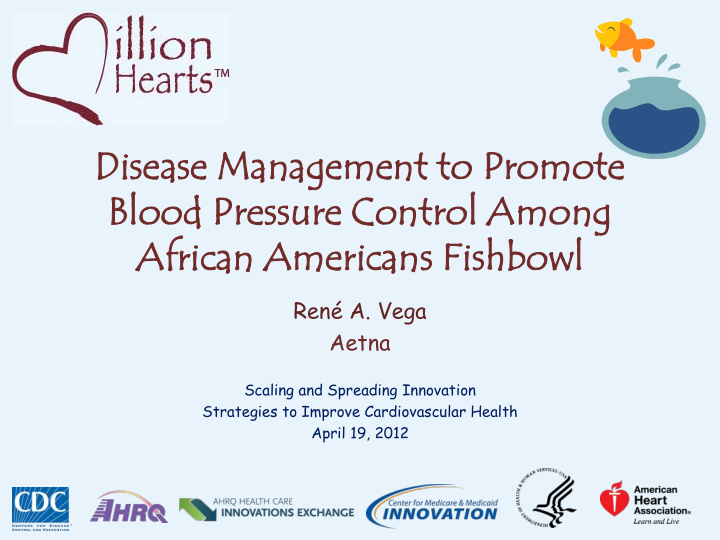



Dise Disease Man anag agement to t to Prom omote te Blood Blood Pressu sure C Con ontr trol ol A Amon mong African an A Ame mericans Fishbow s Fishbowl l René A. Vega Aetna Scaling and Spreading Innovation Strategies to Improve Cardiovascular Health April 19, 2012
Af Afri rican Am Ameri rican an Hy Hyper perten ension – The Fa Facts cts THE DATA Compared to Whites, African Americans have a higher prevalence of hypertension 1,2 African Americans also have higher rates of cardiovascular mortality, stroke, hypertension-related heart disease, congestive heart failure, hypertensive nephropathy, and end stage renal disease 1,2 Controlling blood pressure reduces cardiovascular morbidity and mortality. A 12 to 13 point reduction in blood pressure can reduce the number of heart attacks by 21%, strokes by 37% and all deaths from cardiovascular disease by 25% Estimated direct and indirect cost of hypertension for 2009 is $73.4 billion 1 Archives of Internal Medicine, 1997 2 AHA 2001 Heart and Stroke Statistical Update 3 JNC VII 2004 4 Circulation 2009
Aetna tna’s A African A n America can n Hypertension S on Stud tudy GOALS INITIATIVE RESULTS Two arm study Increase the rate of The CCDMP was clinically acceptable blood evaluating CCDMP effective in increasing pressure measurements and LSP disease the percentage of among African American management program members with clinically members CCDMP components acceptable blood include: pressure by 36% Measure the impact of culturally appropriate initiative on blood pressure compared to the mailings and self care knowledge members in the LSP and behaviors of a outbound member Culturally Competent care calls Disease Management Program (CCDMP) relative to physician cultural a Light Support Program competency training (LSP) quarterly reporting to physicians
Hyp ypertension ion P Pilot ot Program O m Ove vervi view Th e Commercial hypertension pilot program is based on two different initiatives. • One focused on the Medicare population and the other focused on the Commercial African American population, both showing improvements in clinically acceptable blood pressure control The main goal is to improve blood pressure control to within clinical practice guidelines through program outreach, educational support and monitoring The program is expected to have a favorable impact on blood pressure control, productivity and health care costs
Hyp ypertension ion P Pilot ot Program m – El Eleme ments ts Member Identification Member Outreach Member Health Education Biometric Monitoring Member Follow-up
Meas easures res of Su Succes ess Program enrollment rates Improved compliance with BP monitoring Maintain and/or improve medication adherence for anti-hypertension medications Improvement in blood pressure control
Le Lessons ns Le Learn arned – Mov Moving from om Resear arch t to Prac Practice Value demonstration Resource requirements Cross functional integration Speed to market / time to implementation
Disclaimer The findings and conclusions in this presentation are those of the author(s) and do not necessarily represent the official position of the Centers for Disease Control and Prevention or the Agency for Healthcare Research and Quality.
Recommend
More recommend